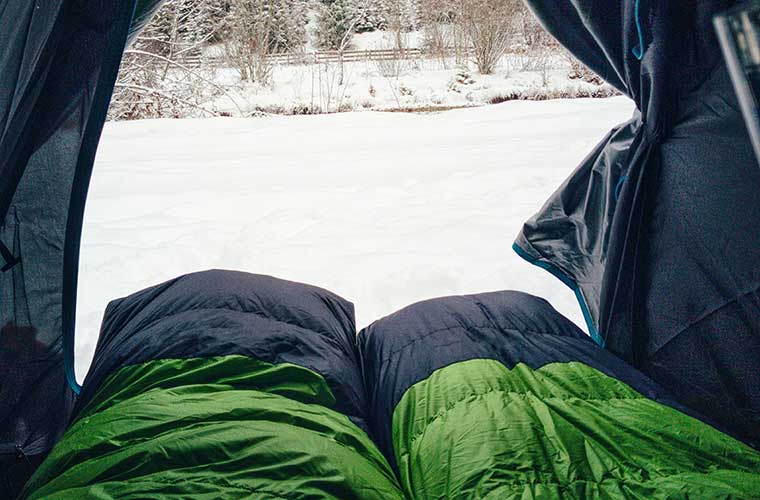How to wash your sleeping bag: useful and practical tips

If you love the mountains, enjoy being close to nature, or are passionate about hiking and camping in the open air, you are probably one of those who always carry with you a basic kit of tools, items and clothing to make these experiences truly safe and unforgettable..
And one of the must-have items for every hiker is the sleeping bag. It is not often absent from the backpackespecially if you are thinking of sleeping away from home. But believe it or not, most people don't know how to keep it clean, free of bad smells, damp, dirt or any other impurities.
So if you are one of those people who don't know what steps to take to ensure that your best friend smells good and is clean when it's time to rest, it's best that you read these lines to the end.
How to wash a synthetic sleeping bag
If the sleeping bag is synthetic it will contain polyester. This material is specially designed to keep you warm and protected inside. And the good news is that it's really easy and quick to maintain.
a) Hand washing
If it has only minor stains that do not require the use of very abrasive detergents or heavy washing, then hand washing is the best option.
You will only need to mix warm water and a little soap in a bowl and use a sponge or soft cloth to wipe the stained or dirty areas. Once the dirt is gone, soak the bag in some clean water without soap and finally let it dry.
On this last point, it is important to remember that synthetic material is very delicate, so if it is exposed to very high temperatures it is likely to suffer considerable damage.
In this sense, it is advisable to let it dry in a warm area, where it does not receive too much heat, otherwise it could be damaged and you will not be able to continue using it.
(b) Automatic washing
You can also use the washing machine to clean your sleeping bag. But be careful, only opt for this plan B if your sleeping bag is in very bad condition: very dirty, smelly or neglected, because these machines are often very aggressive for this material.
This means that it could break, weaken and even shrink, and then when you try to use it again it will not be as comfortable or as safe as before washing it in this machine.
In any case, you should use a mild soap and above all, you should not forget to set the wash mode to "gentle cycle" and wash only with lukewarm water to get the best results, and the temperature does not affect the material.

How to wash a down sleeping bag
They are commonly known as Down Sleeping Bags and are those containing very light goose or duck feathers that act as a powerful and effective natural insulator.
These feathers are composed of extremely fine fibres and even smaller or thinner filaments that branch out from each fibre, creating a kind of 3D insulation that has air pockets capable of retaining heat and keeping you warm all the time.
It is a very light and delicate material, which is perfect as the bag is not heavy or a burden that could cause discomfort to the user. Note that they are more expensive than synthetic sleeping bags, but are much more effective, especially if you will be exposed to colder or warmer climates.
a) Hand washing
This is the least aggressive option, considering that the material or fibres of this type of bag are quite delicate.
So, if you are thinking of removing stains and dirt, you should make sure you have a soap specifically created for this wash. Scrub the soiled or stained areas and once they are gone, rinse the bag in clean water until the detergent is completely gone, and finally let it dry at room temperature preferably.
(b) Automatic washing
As with synthetic sleeping bags, you should set the washing to gentle mode to prevent damage to your sleeping bag. You should also use a special product for washing this type of down to avoid damaging your sleeping bag (detergent for down garments). Do not use a fabric softener.
You should also make sure that the waterproof membrane of the down sleeping bag - usually on the outside - is tucked in, so that it is not damaged.
And as you will see, these are some simple but smart recommendations to follow if you want to prolong the life of your bag.
Once the automatic gentle wash cycle has been completed, it is time to squeeze the bag several times, or until the soap has come out completely.
If the drying is done in a tumble dryer, the temperature should never be higher than 40ºC and we can place some tennis balls next to the bag for proper drying. If drying is done manually, you can shake the garment every so often. Never hang it up, but dry it horizontally. Never expose the bag to high temperatures or direct sunlight.
(c) Professional washing
If the above options seem too risky, difficult or complicated, it is best to leave the maintenance and washing of your sleeping bag to the professionals.
Research the best companies that wash pieces made from this fine down and let them do the work for you, so you can be confident that you will get the results you want without exposing your coat to unwanted damage.
Other recommendations
1. Take care how often you wash your coat.
This means that you don't have to wash your sleeping bag every time you use it, even if it has a small spot on it. In fact, it is often not necessary to wash it completely, i.e. wet it all over - just clean the problem areas with a soft scouring pad or toothbrush.
2. Take your time
Washing a sleeping bag requires work, care and above all, a lot of time. Generally between 2 and 3 hours to wash and dry it, as you must carefully and thoroughly wash the areas that have become soiled, rinse a few times and then leave to dry, so you need to be patient, or else a bad wash could cost you dearly.
3. Control the amount of soap used
Forget about using large quantities of cleaner as this will only make the situation worse. These products are often difficult to rinse off and if used too much can end up damaging the fibres or membranes of the sleeping bag, making it less safe from the weather outside.
READ ALSO:
Don't miss any adventure in the Pyrenees!
